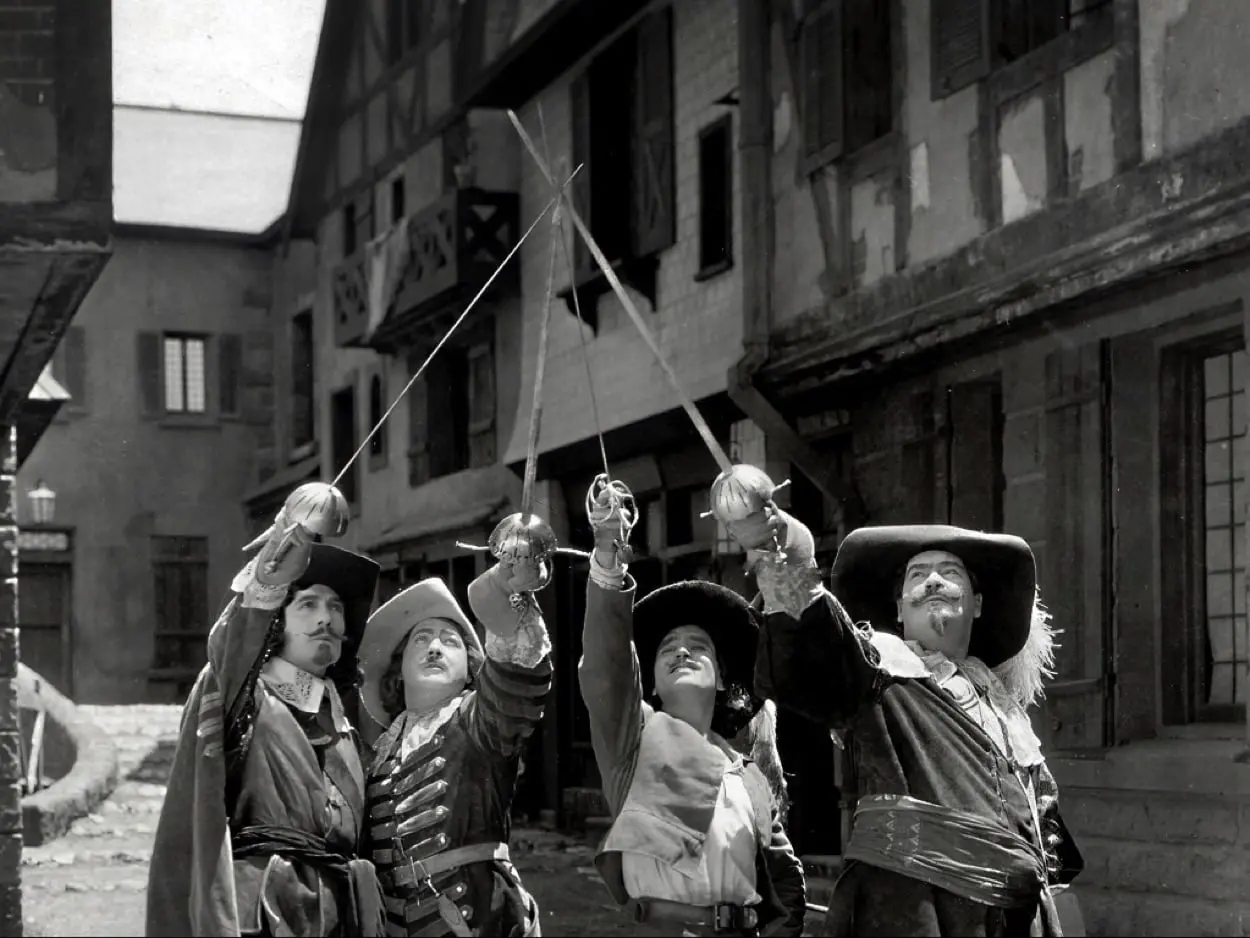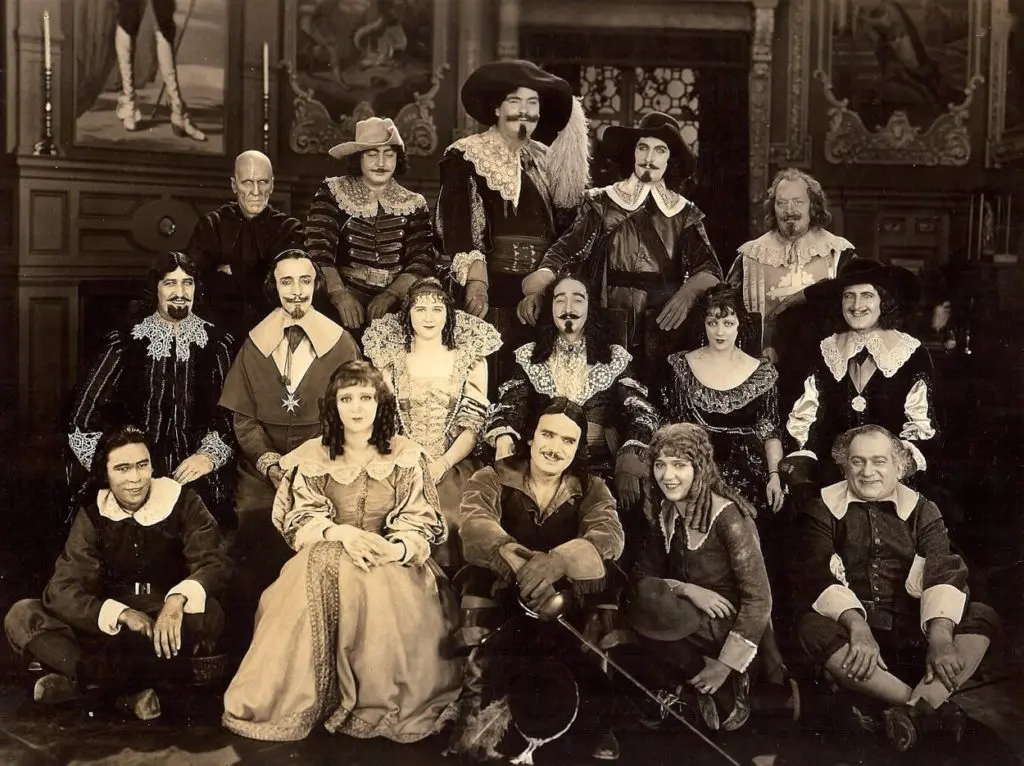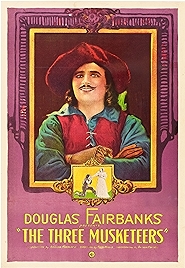You’d have thought that the silent The Three Musketeers from 1921 would be the first film adaptation of Alexandre Dumas’s novel but it wasn’t. Depending on how you count these things it was around the seventh or eighth film version since 1903. It wasn’t even the first of 1921. That honour went to a French serial shot in 14 episodes, Les Trois Mousketaires.
But this one, directed by Fred Niblo and starring Douglas Fairbanks Sr, eclipses all the forerunners and most of the successors, largely thanks to the presence of Fairbanks, cusping 40 when he made this but leaping around and larger than life from the moment he hits the screen.
This happens once Niblo has got all his intrigues and plotting in place – the king (Adolphe Menjou) and Cardinal Richelieu (Nigel de Brulier) playing chess, the Queen (Mary MacLaren) being surreptitiously passed a billet doux by Lady Constance (Marguerite de la Motte) on behalf of the libertine the Duke of Buckingham (Thomas Holding), an exchange noticed by Richelieu’s accomplice Milady de Winter (Barbara La Marr), and which Richelieu intends to use to his advantage. The Queen isn’t interested in Buckingham but who cares about the truth when you’re trying to get a scandal going?
A historical aside. Buckingham really did get about. The English noble known as “the handsomest-bodied man in all England” at one point became Gentleman of the Bedchamber at the court of King James I, a role he took incredibly literally, according to court gossip.
But back to the French court of Louis XIII, where it’s obvious why the Dumas adventure has been adapted so many times. The characters – Louis, Richelieu and Milady in particular – are big, the story is very well known already (handy for a silent film) and the questions it asks about the ruling elite aren’t too troubling. If things have gone wrong it’s not because of the man at the top but instead is the work of some sibilant adviser pouring oil in his ear.
Richelieu is the pivot on which it all turns, in other words, as he is in all the adaptations that follow, and Nigel de Brulier is so good in the role he’d play it another three times – erect, slim-hipped, too courtly, too fastidious and with a tendency to stroke things malevolently, he’s the archetypal Bond villain from top to toe.
D’Artagnan gets one of the most laughable introductions in film history, Douglas Fairbanks sitting on the floor in D’Artagnan’s father’s house as if her were a limber teenager, when in fact he’s nudging 40 and already jowly. In fact Fairbanks’s attempt to hide his incipient double chin throughout is one reason why we remember him in a particular pose – face forward to camera, chin lifted high as if in a defiant “hah!”.
D’Artagnan now introduced, off he heads to Paris, having adventures along the way – all of them familiar from all the other Musketeer films – challenging everyone he meets to a duel, in essence, until he arrives in the capital and winds up doing the same with each of the Musketeers in turn, not realising they are the king’s finest swordsmen. All of which flip-flops when D’Artagnan and the Musketeers join forces after the Cardinal’s men arrive at the duelling ground where they were about to face off. “Four against three?” shouts one of the outnumbered Musketeers towards the Cardinal’s men. “Four against four!” D’Artagnan corrects, in a bit of dialogue that makes it intact into nearly every version.
It’s all done at breakneck speed, and Fairbanks is remarkable throughout. It’s in this first “D’Artagnan and the Musketeers join forces” scene that Fairbanks pulls off his famous one-handed vaulting spring. Though just watching him doing anything – like running up a vast flight of stairs – is to watch a very fit man in action.
Though the image is softish on the 95th anniversary edition I watched, and Niblo isn’t much of a director for close-ups – so much of this film is in long and semi-long shot – we are never in a moment’s doubt as to what’s going on. It helps that intertitles pop up regularly (too regularly for some) to fill us in on the latest plot turn.
The actors respond in kind. These are big, “back of the gallery” performances, declamatory, static, barely a nuance (though notice the king fingering his sword nervously at one point, Menjou managing one of the rare bits of proper film acting in the entire production).
It all, eventually, hinges on a piece of jewellery given to the Queen by the King. If she doesn’t wear it at a court ball it will be a sign that she has given it to Buckingham (she hasn’t, but that’s court intrigue for you) and D’Artagnan and the Musketeers need to race to England, rescue the jewellery and race back to Paris in time to save the day. England is a long way from Paris, and though the pace is breathless, the film slows right down here, as one scene of horses pounding along the highway gives way to another.
There have been plenty of Three Musketeers films since, the most famous being the Gene Kelly 1948 version (no need for Kelly to borrow Fairbanks’s pantomime physicality because he’d already done that), and the Dick Lester 1974 version. Less auspiciously there are the 1993 Bratpack one with Charlie Sheen and Kiefer Sutherland and the 2011 one with Logan Lerman, but all are united in sticking absolutely rigidly to the Dumas story and to the atmosphere of this 1921 version. Knockabout comedy, knockabout action, knockabout intrigue, romance and swordplay. It’s exactly the same tone of deadly earnestness with a wink and technical virtuosity with a shrug that the Mission: Impossible films are still pulling off today. Talking of which, Tom Cruise for D’Artagnan?
The Three Musketeers – Watch or buy the 95th anniversary edition at Amazon
I am an Amazon affiliate
© Steve Morrissey 2021


